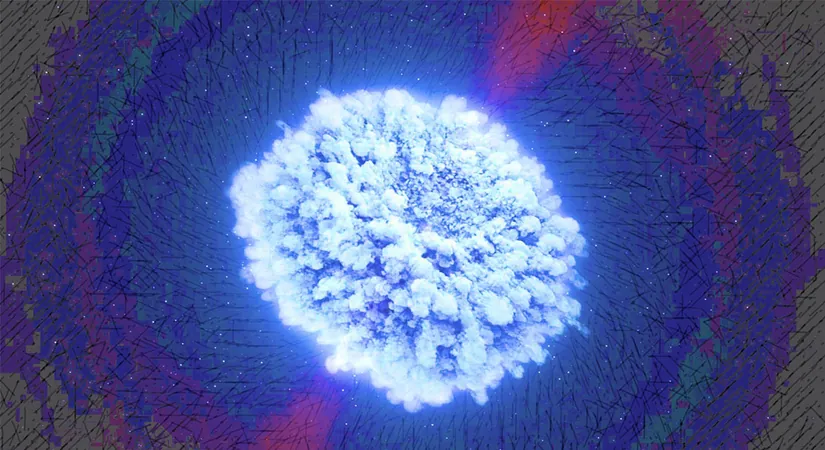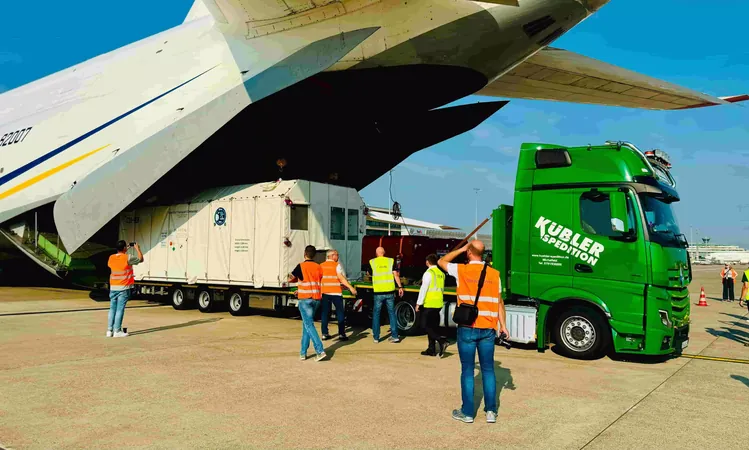
Unraveling Cosmic Mysteries: How Neutron Star Collisions Mirror the Universe's Infancy
2024-11-02
Author: John Tan
Neutron stars, the densest celestial objects known to humankind, are remnants left behind after the catastrophic explosion of supernovae. These enigmatic entities can condense several solar masses into a startlingly small sphere with a radius of merely 20 km. Their collisions result in incredibly energetic phenomena known as kilonovae, releasing energy comparable to that of a short-lived supernova.
When two neutron stars collide, they unleash an avalanche of energy that transforms atoms into a swirling sea of plasma, analogous to the conditions of the early Universe just moments after the Big Bang. This process becomes a vivid showcase for researchers seeking to understand fundamental cosmic events.
Despite the magnificent energy associated with kilonovae, they present significant observational challenges. These fleeting events can diminish in brightness rapidly, making them difficult to track over time. The landmark observation, named AT2017gfo, was recorded in 2017 and marked a pivotal moment in astrophysics—offering the first definitive view of such a cosmic explosion.
Recent studies investigating AT2017gfo, published in the journal Astronomy and Astrophysics, have revealed groundbreaking details regarding the formation of heavier elements in such explosions. This research, led by Albert Sneppen from Denmark's Cosmic Dawn Center, shifts the lens toward how these cosmic events can help us simulate the primordial conditions of the early Universe.
Indeed, the aftermath of a kilonova is marked by the creation of a heavy element-rich environment through a mechanism known as rapid neutron capture, or r-process nucleosynthesis. This process is responsible for synthesizing elements like gold, platinum, and uranium as cooler temperatures enable atomic nuclei to bond together— a phenomenon akin to the formation of atoms in the early Universe as it expanded and cooled.
Utilizing an array of telescopes across multiple continents, including the Hubble Space Telescope, astronomers managed to capture the dynamic evolution of the kilonova as Earth rotated, allowing for a comprehensive view of this dramatic event in 3D over time. This collaborative effort was vital as no single telescope could capture the entire transformation due to the rapid development of the explosion.
As the plasma generated cools, we’ve uncovered insights into the complex formation of various atomic elements, mapping out their evolutionary story. The spectral lines observed during this process, particularly the crucial P Cygni profile, offered significant clues about the expanding gas shells around the kilonova—enabling researchers to measure ejecta’s speed, temperature, and composition in unprecedented detail.
Among the elements synthesized, researchers identified not only the heavier elements previously mentioned but also lighter elements like Tellurium, Lanthanum, Cesium, and Yttrium. The intricate dance of nuclear processes within the aftermath of AT2017gfo illuminates our understanding of how the universe recycles and creates elements crucial for forming stars, planets, and even life itself.
AS revealed by the research, in total, an estimated 16,000 Earth masses of heavy elements emerged from this cosmic explosion, including about 10 Earth masses exclusively comprising gold and platinum—wealth of the cosmos born from cataclysmic events!
Additionally, the gravitational waves detected alongside the kilonova by LIGO in August 2017 present a dual-action event that could further unveil the creation of black holes during neutron star mergers. AT2017gfo was posited to create the smallest black hole ever observed, although discussions are ongoing among scientists regarding its nature, with some suggesting a potential magnetar formation instead.
Kilonovae serve as essential laboratories for astrophysicists, allowing them to explore the extreme physical conditions under which heavy elements are birthed in the universe. Understanding these phenomena enhances our knowledge of cosmic evolution and the intricate dance of stellar life cycles—revealing the complex tapestry that weaves together the very fabric of our Universe.
Stay tuned as research continues to unfold the secrets of the cosmos, proving that even the most cataclysmic events have ramifications that echo throughout time and space!






 Brasil (PT)
Brasil (PT)
 Canada (EN)
Canada (EN)
 Chile (ES)
Chile (ES)
 España (ES)
España (ES)
 France (FR)
France (FR)
 Hong Kong (EN)
Hong Kong (EN)
 Italia (IT)
Italia (IT)
 日本 (JA)
日本 (JA)
 Magyarország (HU)
Magyarország (HU)
 Norge (NO)
Norge (NO)
 Polska (PL)
Polska (PL)
 Schweiz (DE)
Schweiz (DE)
 Singapore (EN)
Singapore (EN)
 Sverige (SV)
Sverige (SV)
 Suomi (FI)
Suomi (FI)
 Türkiye (TR)
Türkiye (TR)